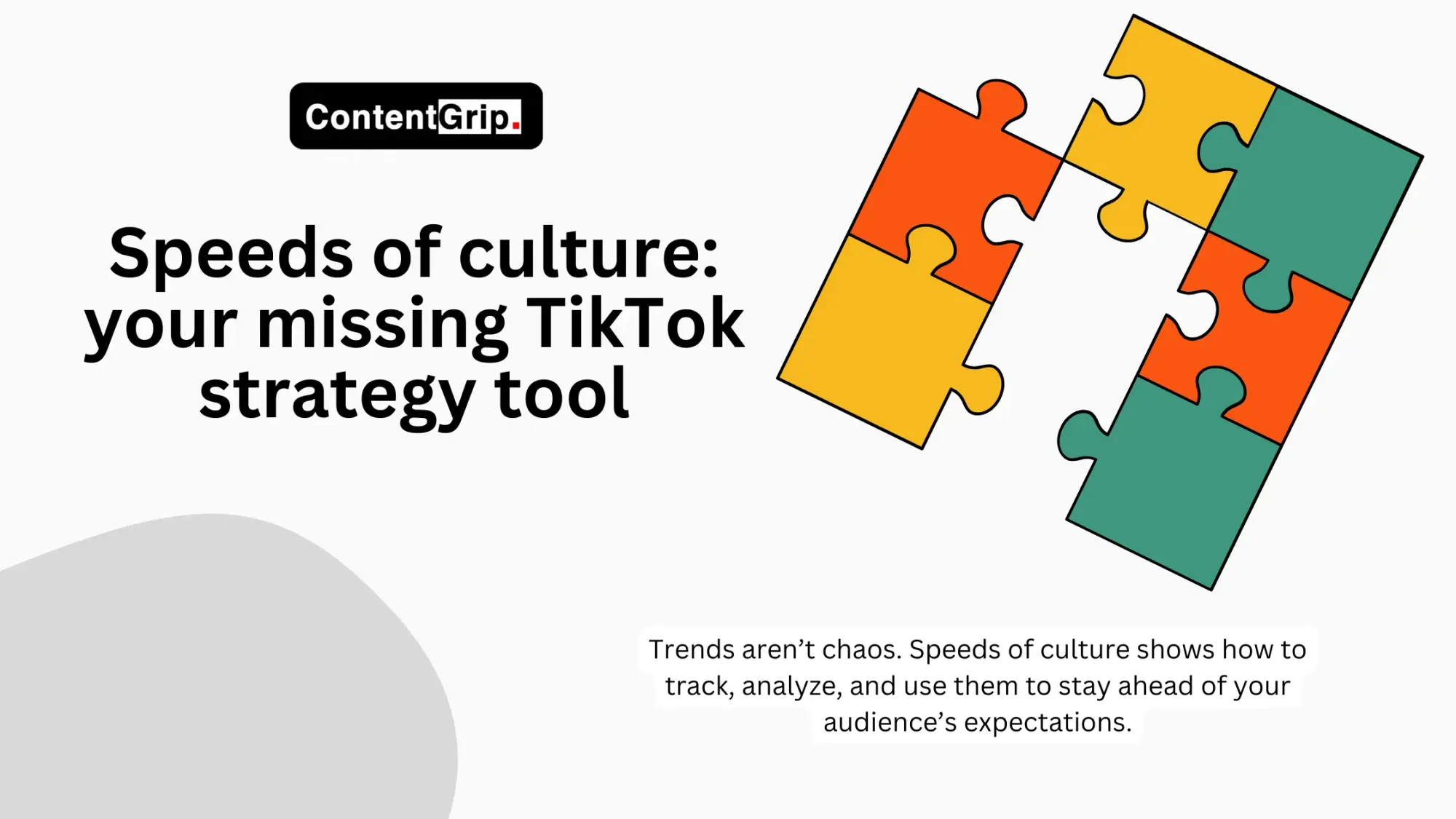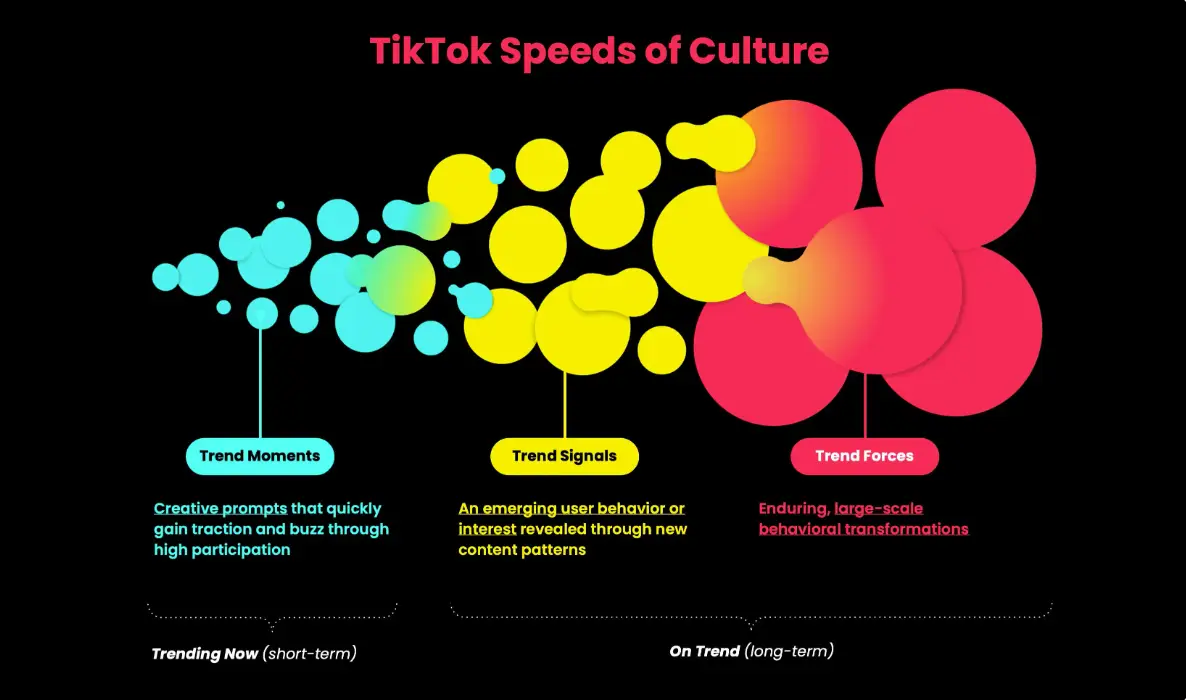You’re wasting time on TikTok without speeds of culture
Trends aren’t chaos. Speeds of culture shows how to track, analyze, and use them to stay ahead of your audience’s expectations.

Trends come and go faster than you can refresh your feed.
For marketers, trying to keep up can feel like running on a treadmill—you’re moving, but are you really getting anywhere? Jumping from trend to trend isn’t a strategy; it’s a reaction.
And it’s why so many brands waste time chasing moments instead of building momentum.
What if there was a way to understand, predict, and act on trends before they peak? That’s where the speeds of culture methodology comes in. It’s a framework that helps you stop guessing and start strategizing.
Speeds of culture breaks trends into clear stages, from fleeting moments to long-term cultural shifts.
By using this approach, marketers can move from reactive to proactive, creating campaigns that connect with their audience while staying ahead of the curve.
💡 Pressed for time? Here’s what matters:
- Speeds of culture is a framework that helps marketers analyze trends by categorizing them into moments (short-term bursts), signals (emerging patterns), and forces (long-term cultural shifts).
- It moves you from guessing to planning by showing when and how to act on trends.
- Use it to spot trends early, decide which align with your brand, and time your engagement based on the trend lifecycle.
- Don’t just follow trends—predict them and plan campaigns that stay relevant longer.
What is speeds of culture?

Speeds of culture is about understanding the impact and lifespan of trends. It divides them into three key stages:
- Moments: The quick bursts of popularity driven by high participation. These are your viral challenges, trending sounds, or hashtags that dominate the platform for a short time.
- Signals: Emerging patterns that reveal new behaviors or interests among users. These signals point to what could become the next big thing.
- Forces: Long-term cultural shifts that shape behavior on a broader scale. These are the trends that go beyond the platform and become part of the larger conversation.
By categorizing trends this way, marketers can decide not just when to act, but how to act.
Are you amplifying a fleeting moment, experimenting with a new signal, or aligning your brand with a cultural force?
The answers shape everything—from content creation to campaign timing.
How marketers can use speeds of culture
Here’s the straightforward truth: following trends isn’t enough. To make an impact, you need to use trends strategically. Here’s how:
1. Identify trends early
Start with observation. Watch for the small but growing signals that could hint at a bigger trend. These might be emerging hashtags, patterns in content themes, or rising creators with unique formats.
2. Assess what’s worth your time
Not all trends are a match for your brand. Before diving in, ask yourself:
- Does this trend align with our audience’s values and interests?
- Can we contribute to it authentically, or will it feel forced?Focusing on what fits saves you from wasting resources on the wrong trends.
3. Engage at the right stage
Timing is everything. Use each stage strategically:
- In Moments, act quickly with lightweight, creative content. This is where spontaneity shines.
- For Signals, experiment. Test ideas, gather insights, and find ways to make the trend your own.
- With Forces, build consistency. Align your brand with long-term movements for sustained impact.
4. Involve your audience
Trends thrive on participation. Instead of talking at your audience, invite them to join the conversation. Challenges, remixes, and user-generated content create deeper engagement and expand your reach organically.
5. Plan for what’s next
The best marketers don’t just follow—they anticipate. Look at the signals shaping user behavior and start planning how your brand can fit into the bigger cultural movements on the horizon. Create content templates and strategies now, so you’re ready when the trend takes off.
Example: Turning speeds of culture into action
Let’s say you spot a new hashtag gaining traction around sustainability—a signal that users are embracing eco-conscious content. Early adopters create videos about reusing materials or upcycling items.
A brand that spots this signal early might produce content showing creative ways to repurpose its packaging. As the trend peaks, the brand amplifies these efforts with collaborations and user-generated content. If this theme evolves into a force, the brand could build long-term campaigns centered on sustainability, tying its identity to the broader cultural shift.
Stop guessing, start strategizing
Speeds of culture is more than a framework—it’s a shift in how marketers approach trends. By understanding the lifecycle of trends, you can stop reacting to what’s happening now and start planning for what’s coming next.
Here’s your next move:
- Watch trends closely and identify the signals that matter to your audience.
- Evaluate which trends align with your brand’s story and audience values.
- Engage strategically based on the stage of the trend.
- Plan for the bigger movements shaping your audience’s behavior.
When you stop chasing trends blindly and start using speeds of culture, you’re not just staying relevant—you’re leading the conversation.


